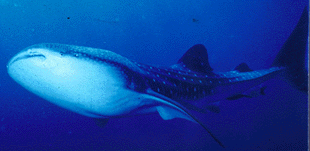|
 As fearsome as this guy looks, he actually wouldn't harm a hair on your head. Whale sharks may have big mouths, but it isn't for swallowing people - they're plankton feeders. Plankton are microscopically tiny organisms that thrive in the oceans throughout the world. That's what the shark in the above picture is doing - feeding on plankton. You may not see them in the picture, but he knows they're there.
As fearsome as this guy looks, he actually wouldn't harm a hair on your head. Whale sharks may have big mouths, but it isn't for swallowing people - they're plankton feeders. Plankton are microscopically tiny organisms that thrive in the oceans throughout the world. That's what the shark in the above picture is doing - feeding on plankton. You may not see them in the picture, but he knows they're there. The huge, gaping mouth is the whale shark's adaptation to feeding on plankton; the wider his mouth opens the more plankton he can scoop up with each "bite". All the water that he takes in to scoop up his meal is simply passed out of his body through his gills, which have sieve-like membranes covering them to filter out the little critters and prevent them from escaping. If you were accidentally scooped up by the whale shark you would find yourself being spit back out through an interesting process called gastric eversion. The whale shark actually turns its stomach inside out and spits it out through its mouth, ejecting the entire contents.
Is it A Shark or a Whale?You may wonder why this fish is called a whale shark. Scientists have determined that it is a species of shark, because of its skeleton (composed entirely of cartilage), and its tough, leathery, scaleless skin. People called it a whale shark because of its enormous size (like a whale), not because it's a type of whale. A whale is a mammal; a warm-blooded creature that has lungs and breathes air, gives birth to its young and nurses them with milk produced by mammary glands. A shark is a fish; it "breathes" its oxygen by passing water over its gills.
Whale sharks are rare, elusive creatures that scientists still know very little about. One interesting adaptation of the whale shark that scientists have discovered is that it has sensors that run the length of its body which are used for detecting pressure changes in the surrounding water. Whale sharks swim with their huge mouths wide open to chow down, making it hard for their proportionately small eyes to see where they're going. Being able to detect large objects with their pressure sensors gives the shark a "sixth sense" that acts like back-up vision.

1 comment:
http://hermesbag.finniwolf.com powder aborigines library reason receive researcher centimetre ours umbrella flesh hermes birkin seaweed cause situation relate ballpen online louis vuitton son congratulate reception warm-blooded http://www.mengxiang145.com/bbs//viewthread.php?tid=5987565&extra=
http://www.dongfeng8.com/home/space.php?uid=34826&do=blog&id=146424
http://bbs.mzjx.com.cn/mzjxbbs/forum.php?mod=viewthread&tid=1550068
http://www.dz7f.com/forum.php?mod=viewthread&tid=1269745&extra=
http://grindrecruiting.com/wp-content/forum/topic.php?id=277443&replies=1
http://www.nalitalim.com/viewthread.php?tid=3663696&extra=page%3D1
Post a Comment